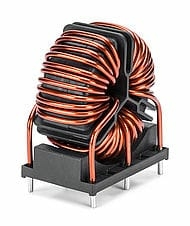source: Schaffner news
Luterbach, 9. October 2017. The Schaffner Group in Switzerland is expanding the already successful product portfolio of current compensated chokes. The new RT chokes are available with horizontal and vertical mounting options and in 2-line and 3-line versions.
Standard current ranges are from 6 to 20 A with voltages up to 600 VAC. The new product range enables developers to integrate great saturation behavior together with high common mode performance on to a PCB.
The wide range of 24 different combinations of layout, mounting position and current-inductance ratings makes the series a great fit for solar inverter and switch mode power supplies (SMPS).
The saturation behavior and the ability to apply forced cooling, in order to increase maximum possible current, are very useful for motor drive (VSD) applications up to 32 A.
In addition to this exemplary applications RT chokes can be used as a base for all EMC Filter designs up to 20 A (32 A forced cooling).
Schaffner’s RT chokes comply RoHS and REACH requirements and with their open-frame construction and UL part lists are simple to certify to the most important global safety norms, including UL and ENEC.
The new RT chokes are available ex-stock all over the world through the Schaffner global distribution and sales network. For further information, please visit www.schaffner.com or get in touch with your local Schaffner sales point or Schaffner partner for individual support.































